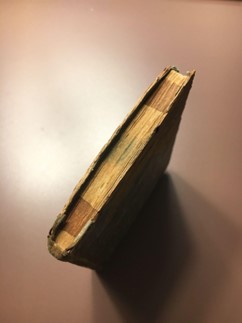Getting Inside the New England Primer
The American Antiquarian Society’s Past Is Present blog recently shared Mitchel Gundrum’s essay on New England Primers, the region’s standard reading textbook for many decades.
Gundrum was at the A.A.S. as a Conservation Intern, having trained in book binding and restoration at the San Francisco Center for the Book, the North Bennet Street School, and West Dean College. His essay analyzed those schoolbooks as physical objects.
New England Primers were little books printed in huge numbers. Gundrum noted two ways the sample of surviving copies differs from the larger body of books from the period.
First, “Of the 269 primers surveyed at the American Antiquarian Society, 105 were bound in scaleboard, 97 in paper wrappers, and 32 in paper-based boards.” And what does “scaleboard” mean?
During his work, Gundrum noticed something else distinctive:
Gundrum was at the A.A.S. as a Conservation Intern, having trained in book binding and restoration at the San Francisco Center for the Book, the North Bennet Street School, and West Dean College. His essay analyzed those schoolbooks as physical objects.
New England Primers were little books printed in huge numbers. Gundrum noted two ways the sample of surviving copies differs from the larger body of books from the period.
First, “Of the 269 primers surveyed at the American Antiquarian Society, 105 were bound in scaleboard, 97 in paper wrappers, and 32 in paper-based boards.” And what does “scaleboard” mean?
scaleboard binding [is] a distinctly early American structure which deserves exploration in its own right. Scaleboard bindings are unique in their use of thin (1–3 mm) wooden cover boards nearly two hundred years after the uptake of paper-based paste- and pulpboard in the West. The lack of a developed papermaking industry in the American colonies, the expense of importing paper products from Europe, and the wealth of natural forest resources in the New World made scaleboard economically preferable in the Colonies, but the practice persisted for a variety of reasons through the 1840s.Perhaps a high proportion of Primers were bound with wood was because customers expected those books to stand up to rougher handling than usual, carried from home to school and back day after day, pawed over by little fingers, perhaps passed down from one sibling to the next.
During his work, Gundrum noticed something else distinctive:
While fully colored and sprinkled edges are fairly common for 18th century bindings, the bands of red, blue, green, or brownish black ink found on several bindings are unique in both appearance and the fact that they are apparently exclusive to the NEP. When I first noticed this decoration during a survey at the Library of Congress, I was ready to write it off as personalization by a previous owner. After gathering more data, however, we’ve found 75 examples of this decoration on imprints spanning 100 years, 7 states, and 20 cities.Because so many printers produced copies of the New England Primer, with customers expecting pretty much the same content, they might have competed on the basis of such decorative details.
Edge decoration is important because these books were produced at minimal cost and maximum efficiency: the extra time and expense required to decorate these books must have had some financial justification. Was the bright decoration a form of advertising for the NEP, meant to catch the eye of children or parents? A nationalist attempt to distinguish the new American product from English imprints with similar content?



No comments:
Post a Comment